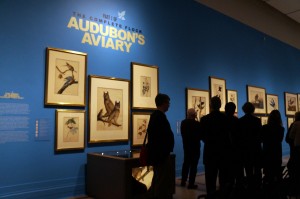 I was thrilled to be invited by the Alumni Office to speak about the Watkinson’s collections related to natural history at an alumni event in New York. The New York Historical Society has mounted the first of three exhibitions of Audubon’s original paintings, most of which were used as the basis for producing the 435 aquatint engravings for his famous Birds of America (completed in 1838).
I was thrilled to be invited by the Alumni Office to speak about the Watkinson’s collections related to natural history at an alumni event in New York. The New York Historical Society has mounted the first of three exhibitions of Audubon’s original paintings, most of which were used as the basis for producing the 435 aquatint engravings for his famous Birds of America (completed in 1838).
Over 40 alumni of Trinity College came out last week on a crisp evening to take a tour of the four large galleries which hold over 160 pieces of art, manuscript letters, and various small artifacts which comprise “Part I” of the exhibition. You can hear the recent NPR story on Audubon, which mentions the exhibition.
 Also joining us was professor Tom Wickman, who has structured a history course around our Enders ornithology collection. We are team-teaching this course in the library, and were delighted that one of our students (and her parents) also made it to the event.
Also joining us was professor Tom Wickman, who has structured a history course around our Enders ornithology collection. We are team-teaching this course in the library, and were delighted that one of our students (and her parents) also made it to the event.
The Society’s docents did an excellent job taking our two groups through the exhibition, explaining in broad strokes the very interesting life that Audubon led, which culminated in the production of his famous (and famously big) book. After the tour, I spoke about our amazing copy of the Birds of America, the plates of which were selected and hand-colored by the engraver himself (Robert Havell, Jr.), and passed from his hands in 1878 to a book firm and then to a Trinity alum, Dr. Gurdon Russell (class of 1834). Dr. Russel owned the set for over 20 years before giving it to Trinity College in 1900, where it has been kept safe and made available to students ans scholars for over a century.
 I concluded my remarks by emphasizing the use to which we put these collections throughout the school year, through presentations, events, and initiatives like our unique Creative Fellowship Program. We all had a great time, and I hope the alums will remember to visit the Watkinson when their classes return to campus for a visit to see the Audubon, which is on permanent display.
I concluded my remarks by emphasizing the use to which we put these collections throughout the school year, through presentations, events, and initiatives like our unique Creative Fellowship Program. We all had a great time, and I hope the alums will remember to visit the Watkinson when their classes return to campus for a visit to see the Audubon, which is on permanent display.
Comments Off on Amazing Audubon Exhibition at NYHS
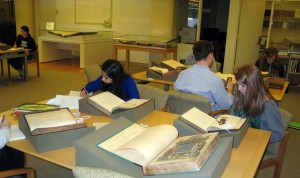 Several days ago we hosted professor Zayde Antrim’s “Mapping the Middle East” class. The students pick a historical atlas and answer a questionnaire about aspects of what they see. Here is the course description:
Several days ago we hosted professor Zayde Antrim’s “Mapping the Middle East” class. The students pick a historical atlas and answer a questionnaire about aspects of what they see. Here is the course description:
“This course approaches the history of the Middle East through maps. It will look at the many different ways maps have told the story of the territory we now call the Middle East and the many different points of view that have defined it as a geographical entity. Readings will analyze maps as social constructions and will place mapmaking and map-use in a historical context. We will relate maps to questions of empire, colonialism, war and peace, nationalism, and environmental change.”

Comments Off on Mapping the Middle East
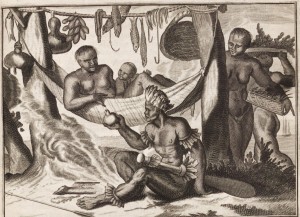 Prof. Alden Gordon & students from Art History 391, Prints and Printmaking, examine an etching in the 1st edition in Dutch of The new and strange world, or, Description of America … (1671). This is the second of 3 or 4 class visits to look at prints from the collection. The students are learning to identify printing techniques by studying examples of woodcuts, engravings, etchings and lithographs.
Prof. Alden Gordon & students from Art History 391, Prints and Printmaking, examine an etching in the 1st edition in Dutch of The new and strange world, or, Description of America … (1671). This is the second of 3 or 4 class visits to look at prints from the collection. The students are learning to identify printing techniques by studying examples of woodcuts, engravings, etchings and lithographs.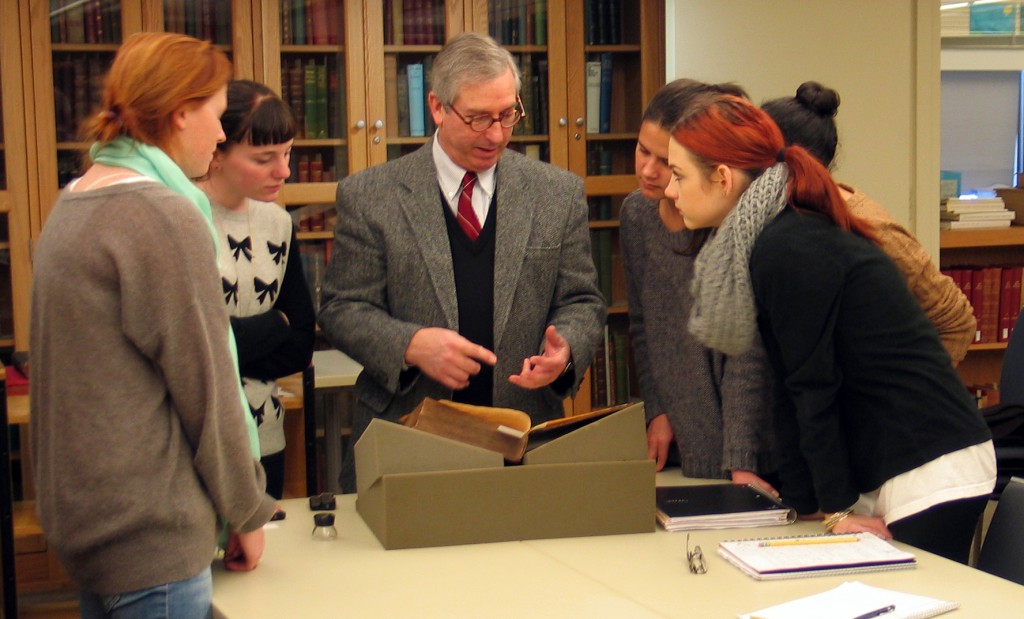
Associate Curator Sally Dickinson is shepherding these visits, which started with early printed books and woodcut illustrations in the profusely illustrated Nuremberg Chronicle (1493) and Albrecht Durer’s series the Life of the Virgin of 1511.
Comments Off on How’d they do that??

On Wednesday we hosted the students in professor Chris Hager’s class (ENGL 379) on Herman Melville, showing our early editions of Typeeand a few of the sources Melville used in writing that novel, as well as Moby Dick.
One of those sources we hold is David Porter’s 1815 Journal of a Cruise made to the Pacific Ocean, an account of the infamous wreck of the Essex, a whaling ship that was attacked by a mad sperm whale, which rammed it to pieces, and left the survivors out in three open boats in the Pacific. A fabulous modern account of this voyage is Nathaniel Philbrick’s In The Heart of the Sea.
 The following is the course description:
The following is the course description:
“Though a superstar during his early career, Herman Melville watched his reputation decline as his literary ambitions escalated. One review of his seventh novel bore the headline, “Herman Melville Crazy.” Not until the 20th century did even his best-known work, Moby Dick, attract considerable attention, but it now stands at the center of the American literary pantheon. Melville’s work merits intensive, semester-long study not only because he is a canonical author of diverse narratives—from maritime adventures to tortured romances to philosophical allegories—but also because his career and legacy themselves constitute a narrative of central concern to literary studies and American culture. Through reading and discussion of several of his major works, we will explore Melville’s imagination, discover his work’s historical context, and think critically about literary form. For English majors, this course satisfies the requirement of a course emphasizing cultural context, or a course emphasizing literature written after 1800.”
Comments Off on Thar she blows!
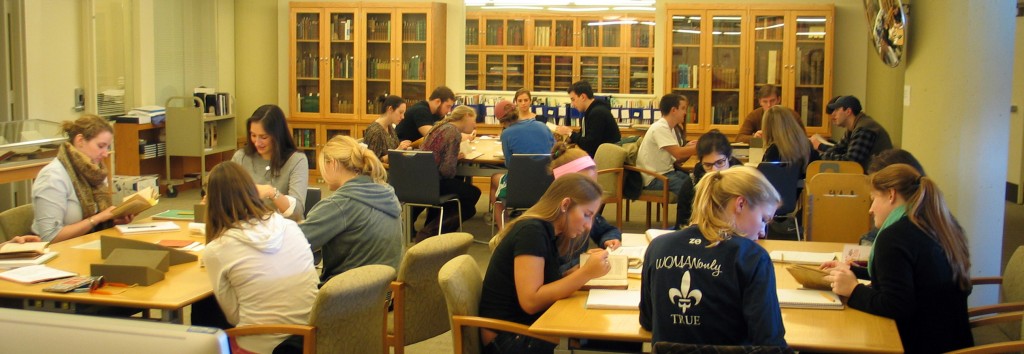
Last Thursday we hosted professor Karen Miller’s American Studies course on “Food and American Culture,” featuring a few dozen cookbooks, recipe books, and other guides. From Miss Beecher’s Receipt Book (1856) to Thomas J. Murrey’s Valuable Cooking Receipts (1886) to The ABC of Wine Cookery (Peter Pauper Press, 1957), there were lots of comments and questions, and much of interest.
Professor Miller’s course description will give our readers some idea of how these students are looking at these sources:
“What we eat and how we eat reflect more than basic physical needs, and food has long played influential roles in defining and representing American culture, identities, and nationalism. Our course will begin by examining the history of the Thanksgiving feast and conclude with contemporary movements in organic and farm-to-table eating. As we explore foods’ implications for Americanism, gender, class, and age, our topics of study will include defining edibles and non-edibles, immigrant influences, food and technology, American farming, diet fads, school lunches and gardens, hunger in America and food regulations. Our class will work with the nearby Billings Forge community to learn more about food’s roles in family life and social reforms, including urban renewal.”
Comments Off on What’s cooking?
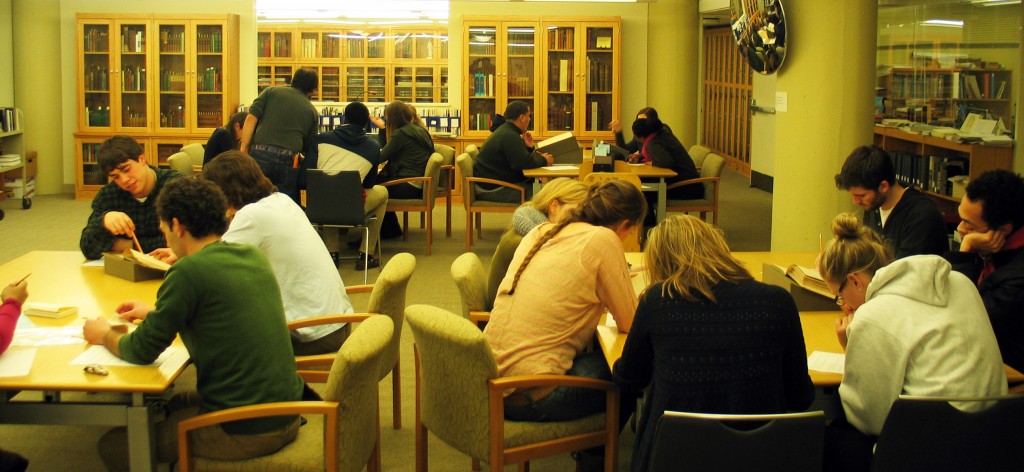 Tonight we hosted Jack Dougherty’s EDUC 300 course entitled Education Reform: Past & Present. The students spent an hour or so examining an array of titles from the Henry Barnard collection. Among those the students used were McGuffey’s readers and spellers from the 1850s; geographies by Jesse Olney from the 1840s and ’50s, and those of David Camp and Joseph Colton of the 1860s and ’70s; Samuel Goodrich’s The young American; or, Book of government and law (1842); and several readers for both young men and women form the 1840s and ’50s.
Tonight we hosted Jack Dougherty’s EDUC 300 course entitled Education Reform: Past & Present. The students spent an hour or so examining an array of titles from the Henry Barnard collection. Among those the students used were McGuffey’s readers and spellers from the 1850s; geographies by Jesse Olney from the 1840s and ’50s, and those of David Camp and Joseph Colton of the 1860s and ’70s; Samuel Goodrich’s The young American; or, Book of government and law (1842); and several readers for both young men and women form the 1840s and ’50s.
As is often the case, more interesting conversations come from pairing the students up with a book and giving them a list of questions to answer, rather than standing in front of them and talking for an hour.
Comments Off on Old textbooks used again!
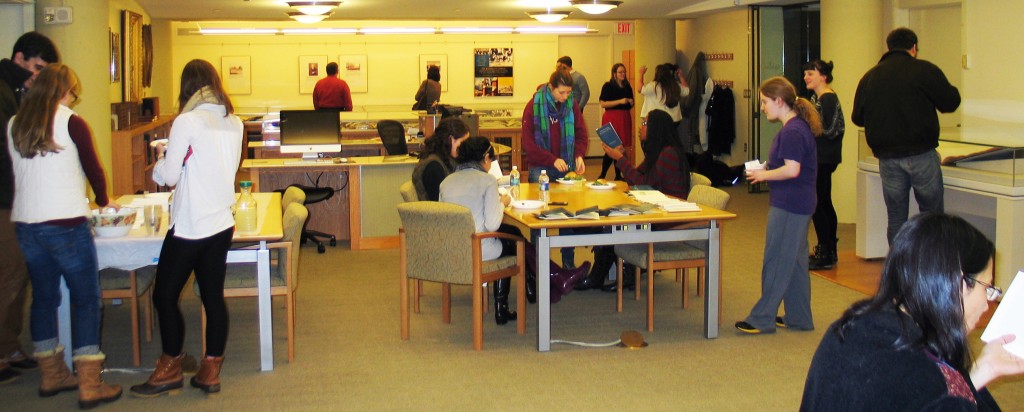 Despite the snow this evening, we had a gratifying turnout for the opening of our two graduate student exhibitions: the first on Trinity and Bates College ca. 1890-1930, and the second on Christmas traditions represented in the Watkinson. This exhibition (and the two printed catalogs which accompany it) were part of the requirements which the students fulfilled in American Studies 835: Museum & Library Exhibitions.
Despite the snow this evening, we had a gratifying turnout for the opening of our two graduate student exhibitions: the first on Trinity and Bates College ca. 1890-1930, and the second on Christmas traditions represented in the Watkinson. This exhibition (and the two printed catalogs which accompany it) were part of the requirements which the students fulfilled in American Studies 835: Museum & Library Exhibitions.
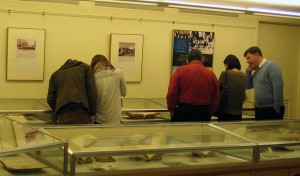 Brent Bette, a history teacher at Simsbury High School who is currently completing an M.A. in American Studies at Trinity, discussed his exhibition comparing Trinity and Bates Colleges. Bette is a graduate of Bates, and has been collecting ephemera relating to his alma mater since graduation. His items are placed along side those he selected for comparison from the Trinity College Archives.
Brent Bette, a history teacher at Simsbury High School who is currently completing an M.A. in American Studies at Trinity, discussed his exhibition comparing Trinity and Bates Colleges. Bette is a graduate of Bates, and has been collecting ephemera relating to his alma mater since graduation. His items are placed along side those he selected for comparison from the Trinity College Archives.
Jenn Brasfield, also in the American Studies M.A. program, was inspired to put up a Christmas-themed exhibition when she discovered that the Watkinson held an array of British and American Christmas cards dating back to the mid-19th century.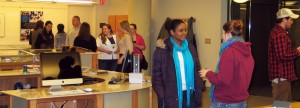
The catalogs (covers below) were written by the students, designed by Michael Russem of Kat Ran Press (Cambridge, MA), and printed at Trinity College.
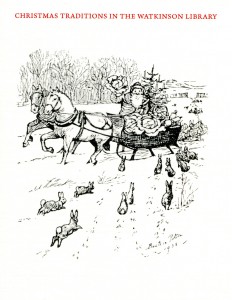

Comments Off on Student Exhibitions!
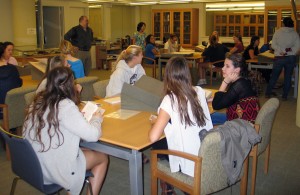 Yesterday we hosted professor Karen Miller’s class on ” Female Bodies in the Nineteenth Century,” and the students examined a myriad of sources, including frontier newspaper ads from the 1880’s, issues of Harper’s Weekly from the 1860s and 1890s, huckster medical guides, and legitimate obstetric manuals spanning the 19th century. The students took turns presenting sources they were given (at random), and generally agreed that the parallels and the differences between Victorian-age and modern advice on beauty, child-rearing, and proper behavior for women were fascinating.
Yesterday we hosted professor Karen Miller’s class on ” Female Bodies in the Nineteenth Century,” and the students examined a myriad of sources, including frontier newspaper ads from the 1880’s, issues of Harper’s Weekly from the 1860s and 1890s, huckster medical guides, and legitimate obstetric manuals spanning the 19th century. The students took turns presenting sources they were given (at random), and generally agreed that the parallels and the differences between Victorian-age and modern advice on beauty, child-rearing, and proper behavior for women were fascinating.
Comments Off on What to Expect from your 19thC doctor
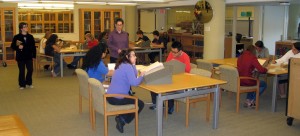 Yesterday afternoon we were happy to host Erin Valentino’s First Year seminar (“The Information Age & the Digital Divide”), as the students cover a unit on print culture and book history. Each student has picked a book from the Watkinson (which range in date from ca. 1400 (a medieval Book of Hours) to 1860 (a guide for sailors) as a focus for their research. Each student will write a contextualizing label, and all of the books (or scans, for the most valuable) will be placed on display in the Main Library’s atrium. The “opening” event of this exhibition will be held during Common Hour on Tuesday, October 23rd.
Yesterday afternoon we were happy to host Erin Valentino’s First Year seminar (“The Information Age & the Digital Divide”), as the students cover a unit on print culture and book history. Each student has picked a book from the Watkinson (which range in date from ca. 1400 (a medieval Book of Hours) to 1860 (a guide for sailors) as a focus for their research. Each student will write a contextualizing label, and all of the books (or scans, for the most valuable) will be placed on display in the Main Library’s atrium. The “opening” event of this exhibition will be held during Common Hour on Tuesday, October 23rd.
Comments Off on Budding Curators from the Freshman Class!
 During “reunion week” (the second week of June) this year there were several opportunities to see Watkinson rarities. On Wendesday the 6th about a dozen alumni attended a presentation entitled “John James Audubon: American Dreamer.” Born in Haiti, educated in France, and sent to America to avoid the draft (i.e. Napoleon’s conscripted legions), Audubon is an early example of American self-fashioning. Works by Audubon, as well as his contemporaries Alexander Wilson and Prideaux John Selby, and his fore-runner Mark Catesby, were out on display for folks to view.
During “reunion week” (the second week of June) this year there were several opportunities to see Watkinson rarities. On Wendesday the 6th about a dozen alumni attended a presentation entitled “John James Audubon: American Dreamer.” Born in Haiti, educated in France, and sent to America to avoid the draft (i.e. Napoleon’s conscripted legions), Audubon is an early example of American self-fashioning. Works by Audubon, as well as his contemporaries Alexander Wilson and Prideaux John Selby, and his fore-runner Mark Catesby, were out on display for folks to view.
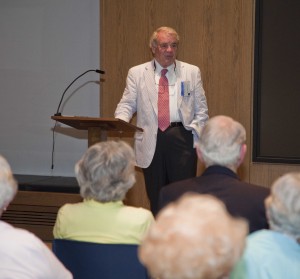 On Friday a crowd of some 40-50 people (mostly Class of ’57) enjoyed a screening of David Elliott’s award-winning film The Curious Mr. Catesby (2007). Mr. Elliott (’57) is the Executive Director of the Catesby Commemorative Trust. I brought out the Watkinson’s copy of the first edition of Catesby’s Natural History of Carolina, Florida and the Bahama Islands (1731-43) and showed it to an appreciative crowd. Trinity was able to purchase this copy in 1883 through the generosity of a “rich uncle” of a Trinity alumnus (George Lewis Cooke, class of 1870).
On Friday a crowd of some 40-50 people (mostly Class of ’57) enjoyed a screening of David Elliott’s award-winning film The Curious Mr. Catesby (2007). Mr. Elliott (’57) is the Executive Director of the Catesby Commemorative Trust. I brought out the Watkinson’s copy of the first edition of Catesby’s Natural History of Carolina, Florida and the Bahama Islands (1731-43) and showed it to an appreciative crowd. Trinity was able to purchase this copy in 1883 through the generosity of a “rich uncle” of a Trinity alumnus (George Lewis Cooke, class of 1870).
The next day a steady stream of visitors were able to view the “bird of the week” from John James Audubon’s Birds of America set, which has been at Trinity for 112 years, as well as the newly acquired 2nd Folio of Shakespeare. At 1:30, with the help of Watkinson Trustee Jack Enders (’92), I presented a selection of recent acquisitions of ornithology material for the Enders collection, given by his grandfather, Ostrom Enders in the 1980s.
Comments Off on The Watkinson during Reunion Week!
 Several days ago we hosted professor Zayde Antrim’s “Mapping the Middle East” class. The students pick a historical atlas and answer a questionnaire about aspects of what they see. Here is the course description:
Several days ago we hosted professor Zayde Antrim’s “Mapping the Middle East” class. The students pick a historical atlas and answer a questionnaire about aspects of what they see. Here is the course description:

















